|
Posted: 8/6/2017 3:16:56 PM EDT
This thread is for all things 2017 eclipse-related.
Totality will cross the entire continental United States, starting on the Pacific coast south of Portland, OR around 10:15 am PDT, traveling southeasterly through Kansas City, MO (1:05 pm CDT), and leaving the mainland at Charleston, SC around 1:15 pm EDT.  NASA_map_508 by FredMan, on Flickr NASA_map_508 by FredMan, on Flickr
|
|
|
|
The reason we can have theses spectacular eclipses is that, for an Earthbound viewer, the apparent diameter of the sun and the moon is nearly identical, allowing the moon to just occlude the sun.
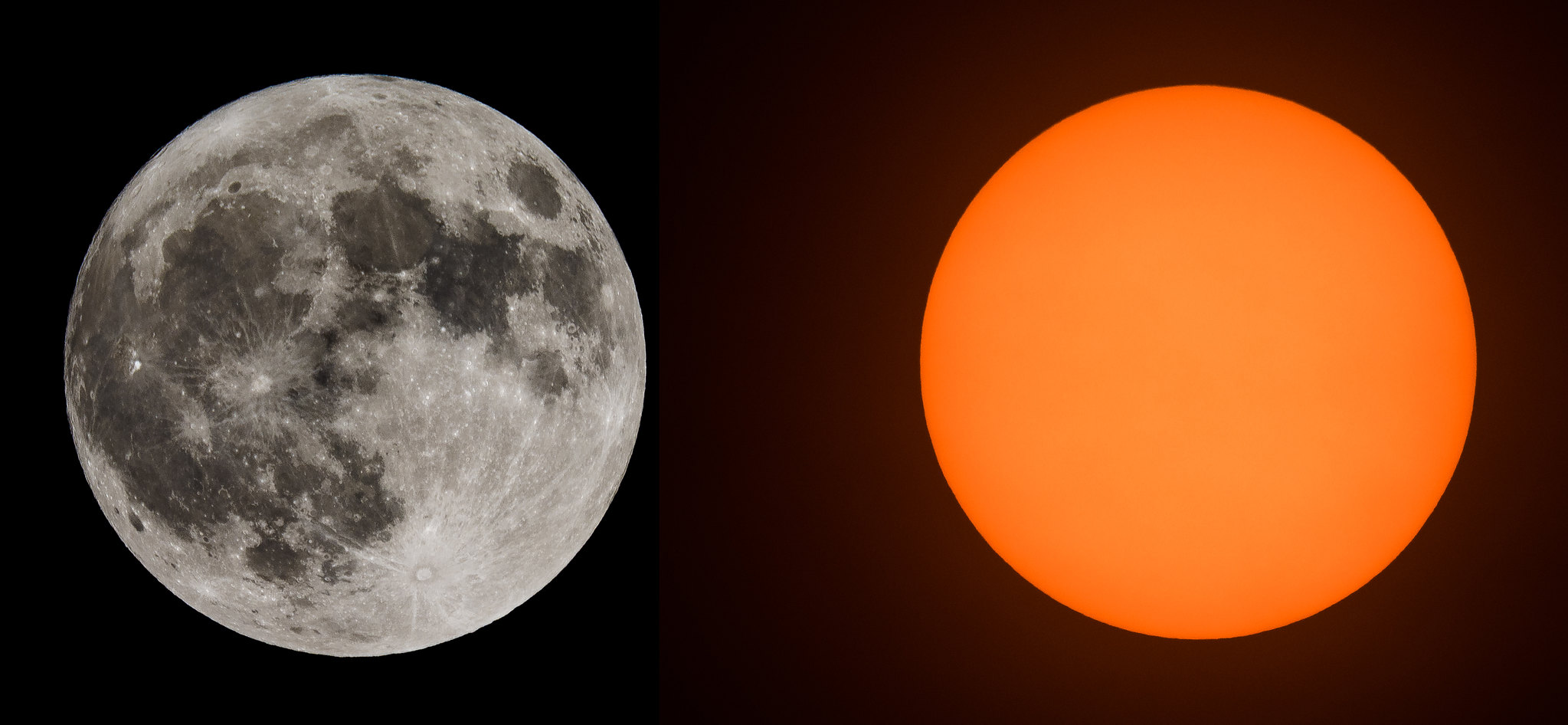 DSC_9161-DSC_5970 Sun and Moon by FredMan, on Flickr DSC_9161-DSC_5970 Sun and Moon by FredMan, on Flickr
 DSC_9161-DSC_5970 Sun Superposed Moon by FredMan, on Flickr DSC_9161-DSC_5970 Sun Superposed Moon by FredMan, on Flickr
One of the things I'm trying to do is set up a "covering/uncovering" sequence of the eclipse. I want to leave the camera stationary and then just stack the images in post. I figure I need to set my interval for a minimum of 2 sun diameters so each shot in the sequence won't be occluded by the previous (I'm allowing for double diameter just to make sure the sun/moon system, as it approaches totality, won't affect any other frames in the stack). My task is to: 1. Figure out the diameter movement of the sun. Need this for the proper 2-diameter "spacing" 2. Figure out the focal length that will get me, say, 3 shots of waxing eclipse, one at the moment, and then 3 shots of waning eclipse. I want to maximize my subject size on the sensor, so 3. Set up an interval timer and start it at "half life" of the total interval before the peak of totality. That way I get equal shots before and after. This 6-minute moon interval at 120mm looks like it's about 2.5-3 diameters. Note that there were actually 2 throw-away frames in this stack; the moon moved across the entire sensor in 8 6-minute intervals, or 48 total minutes. This image is cropped to provide equal "blackspace" on either side of the stack.  Moon 120mm Transit 6 minute Interval by FredMan, on Flickr Moon 120mm Transit 6 minute Interval by FredMan, on Flickr
So, a good starting point is going to be 120mm and 5 or 6 minute intervals. This is 300mm and a 3-minute interval. Only 4 frames, but two were throwaway as the sun moved "up" out of the frame instead of "left to right" out of the frame (my goal). Again, this frame has been cropped to equalize "blackspace" 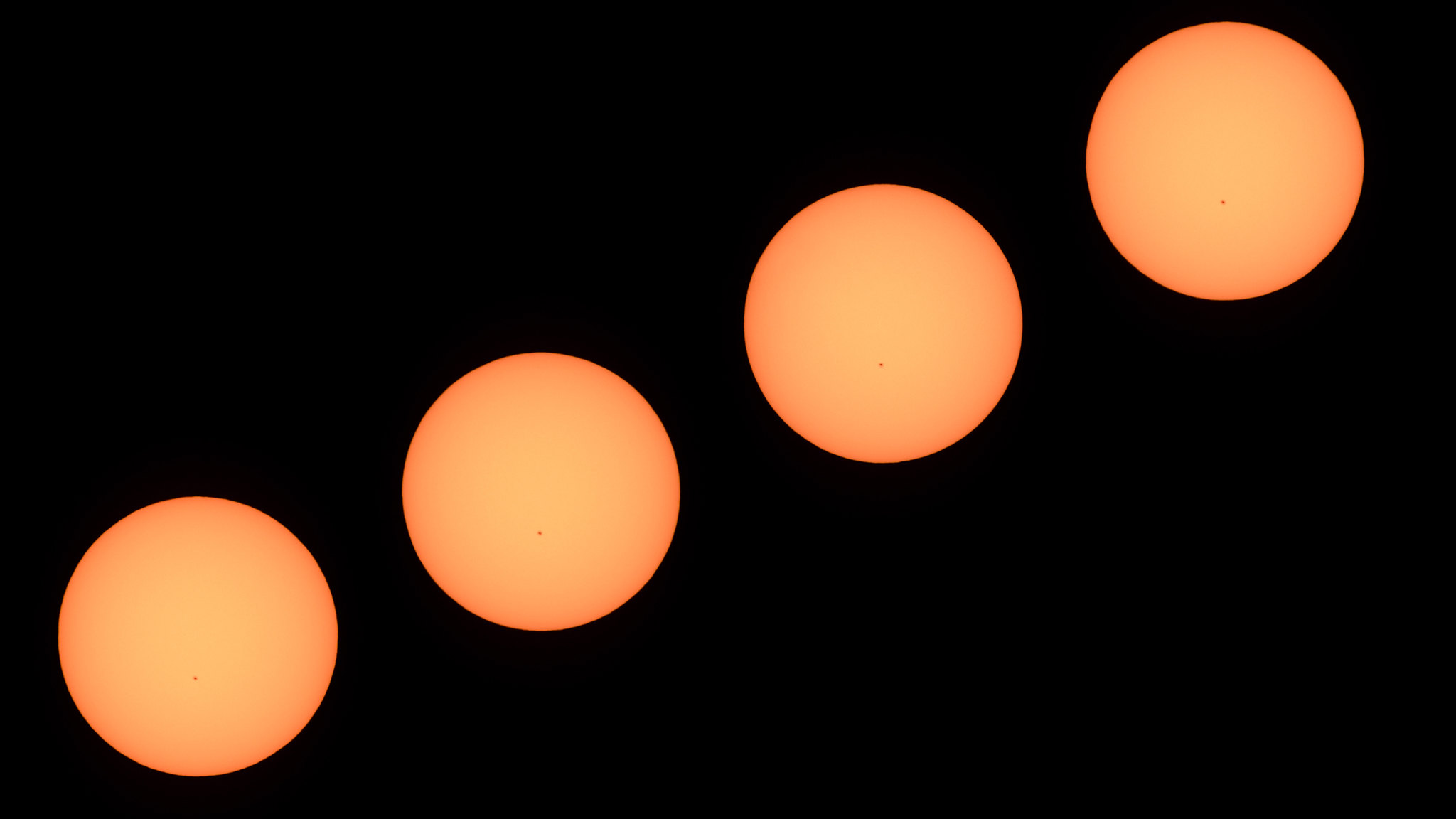 Sun 300mm 3 Minute Interval by FredMan, on Flickr Sun 300mm 3 Minute Interval by FredMan, on Flickr
Clearly, 300mm and 3 minutes is way too short a time, and way to long a focal length. My next experiment is 250mm and a 5-minute interval. This frame is NOT cropped. And you can see the next task is to get that damn camera oriented correctly. Here in the southeast the sun will be almost directly overhead. I'm thinking that mounting the camera on it's "side" (vertical framing), orienting it at about 260 degrees per the compass, tilting it up so the sun is just in the upper left corner of the frame, and giving it about a 15-degree list to the south will get me a "falling sun" from the upper left to lower right corners of the frame.  Sun 250mm 5 Minute Interval by FredMan, on Flickr Sun 250mm 5 Minute Interval by FredMan, on Flickr
I think the 5-minute interval is dead on, but 250mm is still too long. I don't think I can get 7 intervals in the same frame at 250mm. My next experiment will be at 200mm, but that'll have to wait as clouds are now rolling in (bah!). |
|
|
|
I must be the only one in the country who is not excited about this eclipse. I was in Meridian, MS for the solar eclipse in 1984, and it was basically a non-event. It was a bright sunny day, and I think we had about 90% coverage, and at most, the sky looked similar to the way it looks around late afternoon, with maybe a sort of unusual looking tint.
I mean, really, it was just nothing. 
|
|
|
|
You may be wondering, what settings should I use to shoot the eclipse?
What I've discovered, for an uncovered sun (i.e. everything but totality) what seems to work is: All shots with the TRhousand Oaks Solar Film, at 16-stop reduction in light transmission. That's 2^16 times less light, or 1/65536 as much light, or about 0.0015% as much light. Tamron 150-600, at 600mm: 1/40 sec, f/9, ISO 400 Nikon 70-300, at 200mm: 1/80 sec, f/6.3, ISO400 Nikon 24-120, at 24mm: 1/160, f/4, ISO 100 These all give me about +1 EV Here's a chart NASA put together, read all the details regarding ND filters, ISO, focal length, etc. YMMV!! 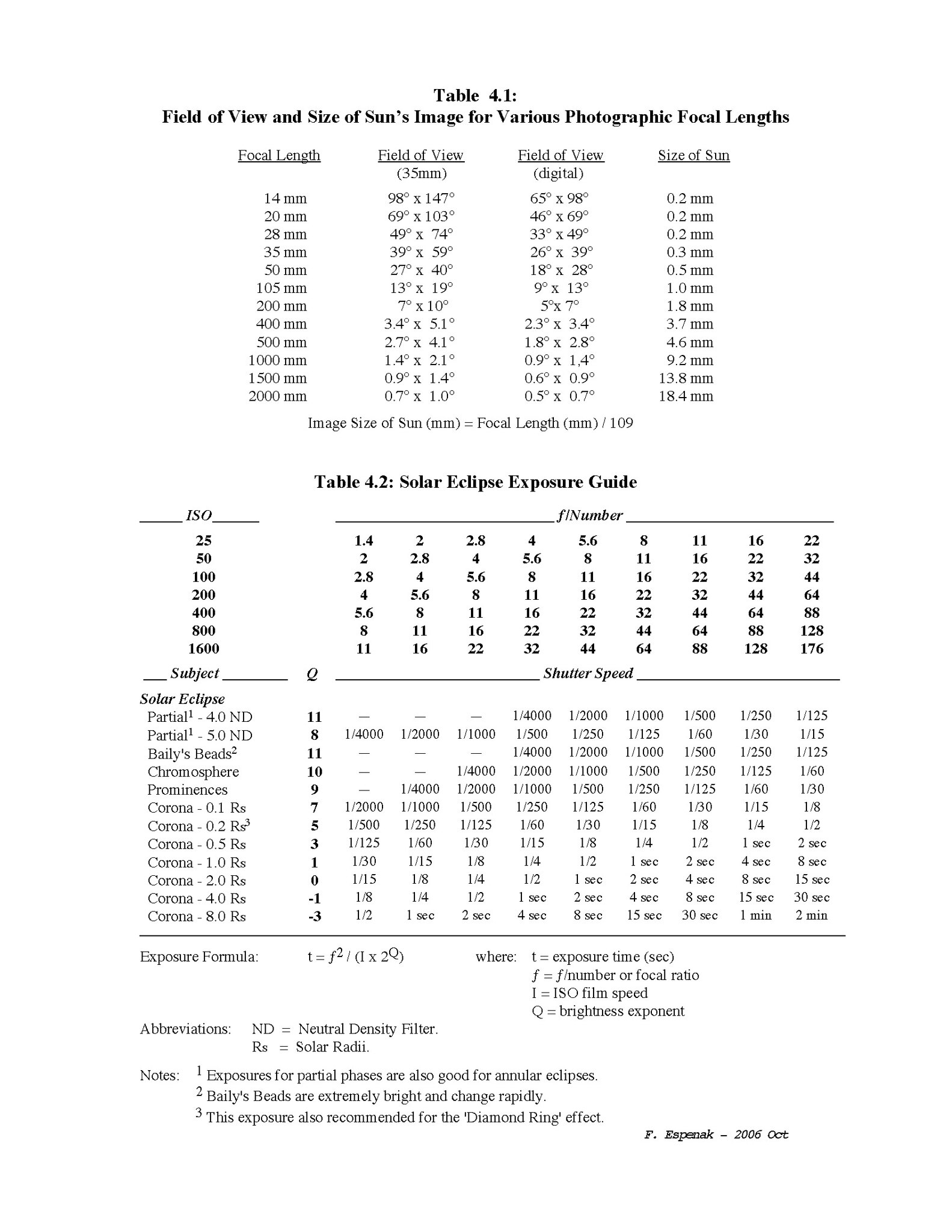 Eclipse SEphoto-table by FredMan, on Flickr Eclipse SEphoto-table by FredMan, on Flickr
|
|
|
|
For my interval shots three other settings I'm using are:
Mirror-up 3-second delay electronic front curtain And of course turning off VR while on the tripod. It's not perfect (I'd like a longer delay), but those settings trigger the mirror up at time 0 and then trigger the shutter at +3 seconds. I'm actually amazed that with the interval and using exposure delay with mirror up it actually gives you a few seconds for the camera to settle after triggering the mirror. The whole point of these settings is to minimize any kind of camera shake at long focal lengths on the tripod. |
|
|
|
I'll either be in the Tetons or the Wind River range in Wyoming for totality. I don't really feel the need for shooting just the sun/moon, my plan is to shoot some landscapes that might include the eclipse as an element. I do have my 200-500mm Nikkor with some solar film just in case I change my mind though.
I never have good luck with weather out there either so I'm just hoping for the best. |
|
|
|
Prob too late to get some of that film, is there anything else I can use? I was going to try to get some shots with my old G2 digital mirrorless or another digital on a tripod. I didn't think about it until now...
ETA: I have an IR filter, an N72. Not sure how it will work, but better than nothing. I ordered a 3"x3" piece of the thousand oaks solar lite film next day shipping that might be here in time... Plan is to tripod the cam and do a sequence as the shadow passes by. I should have thought about this sooner. 
|
|
|
|
I got my TO film the other day, finished the DIY mount to my 300mm, and gave it a test yesterday... nice.
I was going to stay home and watch (92%), but said WTF yesterday and am going to make the 3hr drive to Nebraska monday morning. there is probably going to be a flood of people driving to WY, so I'm going the other way. Wx looks great... |
|
|
|
|
|
Saw this late last night. Neat little video as to what will happen if you don't shoot with a filter.
https://petapixel.com/2017/08/19/shooting-sun-without-filter-can-melt-dslr/ |
|
|
|
Quoted:
Saw this late last night. Neat little video as to what will happen if you don't shoot with a filter. https://petapixel.com/2017/08/19/shooting-sun-without-filter-can-melt-dslr/ View Quote |
|
|
|
I'm going to head out later tonight.
I'm trying to get a star trail time lapse above a waterfall with my DSLR, and then track the eclipse from roughly the same spot with my GoPro. If I'm using a 24mm lens, would I need to use filters to protect the sensor? I'm just staying in the local area, so the sun will be about 90% covered. |
|
|
|
So I've decided I'm going to run 3 cameras.
D500 with the 150-600, at 600mm, for close-ups. D7100 with the 70-300, at 200mm, for interval shots at 5 minutes, starting 30 minutes before the peak. D200 with the 24-120, at 24mm, for interval shots (5 minutes) from 1:11 pm to 4:08 pm, to catch as much of the entire sequence as it's FOV will allow NASA has a VERY cool interactive map; you can click anywhere and it will tell you the start time, peak time, stop time, azimuth, and altitude at that location. Going to take a lot of the guesswork of getting my cameras set up and oriented properly. NASA Interactive Eclipse Map And here's a handy reference if you want to figure out the field of view of your lens, to see if it could capture the entire sequence. FOV Table For example, using the NASA map, i find that the sun will cover 66 degrees of azimuth, and 19 degrees of altitude. My 24-120 lens, at 24 mm, will cover 52 degrees horizontal, 36 degrees vertical, and 60.7 degrees diagonal. I plan on using a compass and clinometer to angle my tripod to the azimuth and altitude for the peak (from the NASA map) and just roll with it. |
|
|
|
If I'm using a 24mm lens, would I need to use filters to protect the sensor? View Quote |
|
|
|
Well, my film order got cancelled and there's none available in town, AND nobody has big enough welding glass, so I'm out.
|
|
|
|
|
|
|
|
600mm sequence, from 23 minutes after start, maximum, and 23 minutes before end.
The photo Gods were kind to me for this sequence!  Eclipse 600mm Sequence by FredMan, on Flickr Eclipse 600mm Sequence by FredMan, on Flickr
|
|
|
|
im an hour north of ground zero, columbia sc, it was kinda neat to have the outside lights come on and some crickets chirp chirp a little
but i am sure glad I didnt drive 6 hours to see what I saw |
|
|
|
Awesome sequence Fred. I'm already excited for the 2024 eclipse as totality will be from Maine to Texas. That puts me within an hour drive or so.
|
|
|
|
Not quite the way I hoped; didn't get the camera correctly positioned. 5-minute interval and I was hoping to capture it coming and going from maximum. And thin clouds rolled in on the middle frame.
This was with the D7100.  Eclipse 200mm 5-Minute Interval by FredMan, on Flickr Eclipse 200mm 5-Minute Interval by FredMan, on Flickr
|
|
|
|
Quoted:
I must be the only one in the country who is not excited about this eclipse. I was in Meridian, MS for the solar eclipse in 1984, and it was basically a non-event. It was a bright sunny day, and I think we had about 90% coverage, and at most, the sky looked similar to the way it looks around late afternoon, with maybe a sort of unusual looking tint. I mean, really, it was just nothing.  View Quote A FULL solar eclipse on the otherhand is amazing. |
|
|
|
Quoted:
Partial eclipse like what you described is basically a non-event... cant hardly tell anythings going on unless you have the glasses and even then its meh. A FULL solar eclipse on the otherhand is amazing. View Quote View All Quotes View All Quotes Quoted:
Quoted:
I must be the only one in the country who is not excited about this eclipse. I was in Meridian, MS for the solar eclipse in 1984, and it was basically a non-event. It was a bright sunny day, and I think we had about 90% coverage, and at most, the sky looked similar to the way it looks around late afternoon, with maybe a sort of unusual looking tint. I mean, really, it was just nothing.  A FULL solar eclipse on the otherhand is amazing. Honestly, I'm not sure I would even get excited about a full eclipse. 
|
|
|
|
|
|
|
|
|
|
|
|
|
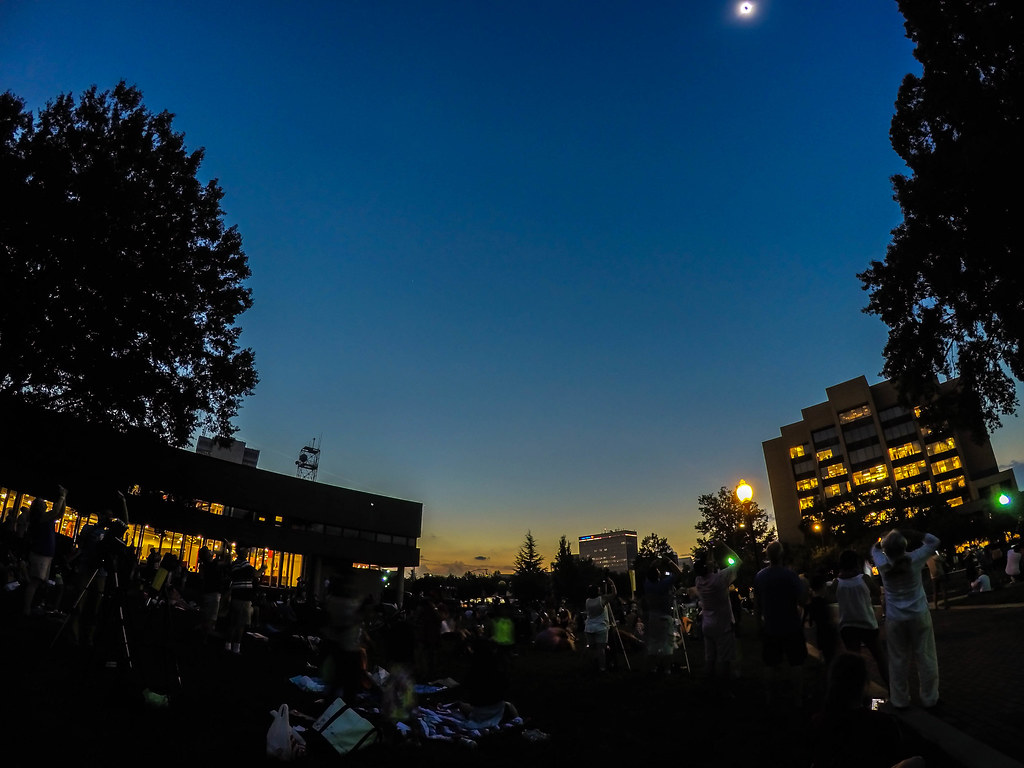 G0025648.jpg by gmartell69, on Flickr G0025648.jpg by gmartell69, on Flickr
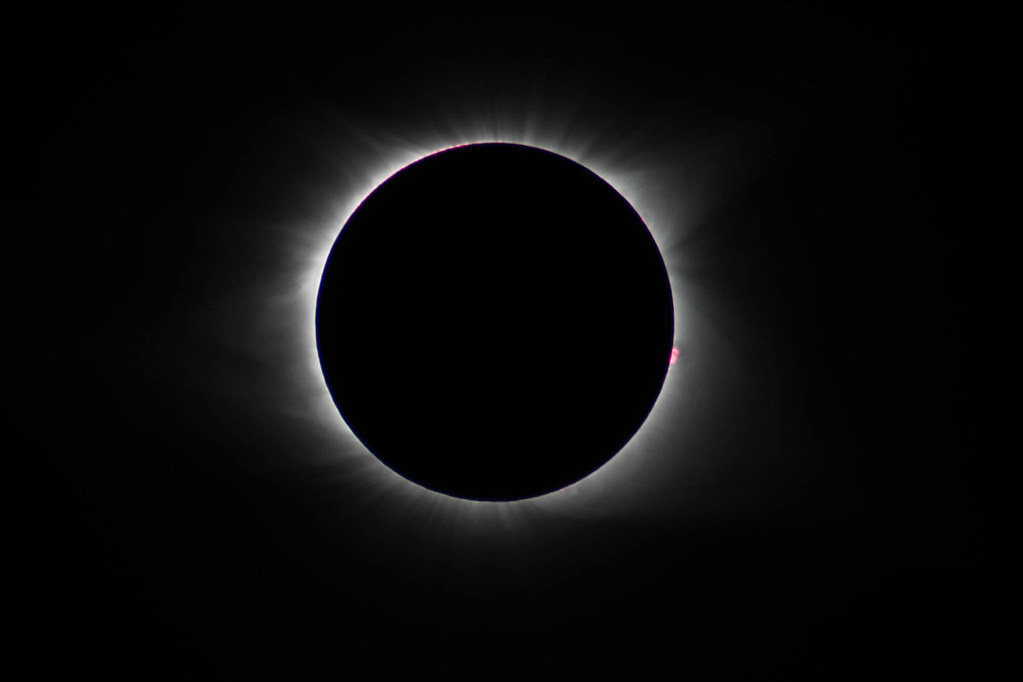 DSC_0105.jpg by gmartell69, on Flickr DSC_0105.jpg by gmartell69, on Flickr
 DSC_0100.jpg by gmartell69, on Flickr DSC_0100.jpg by gmartell69, on Flickr
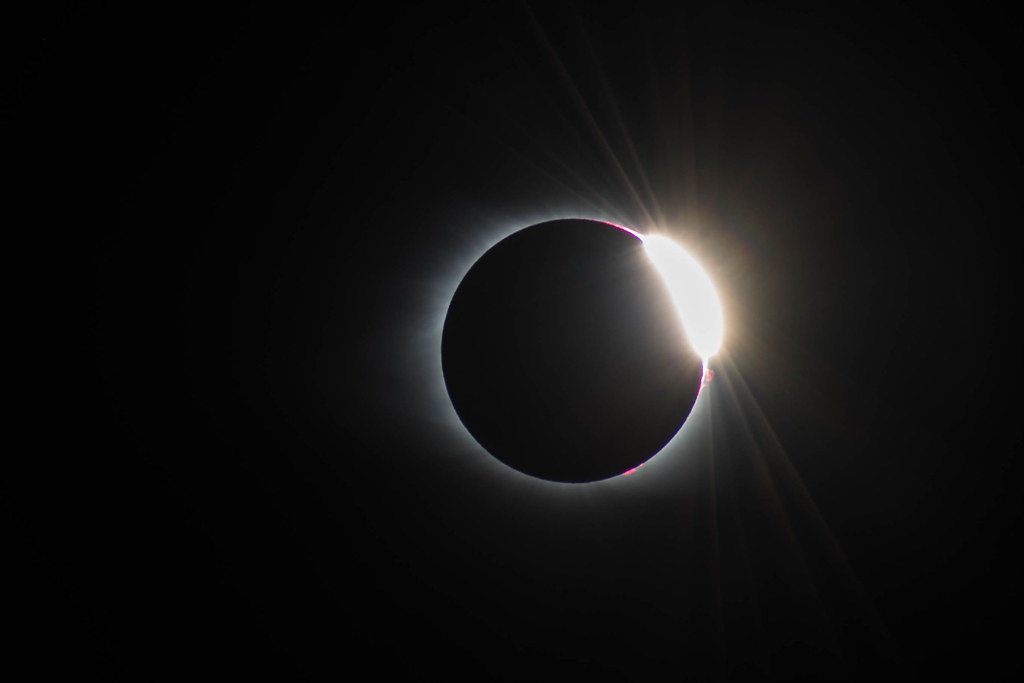 DSC_0126.jpg by gmartell69, on Flickr DSC_0126.jpg by gmartell69, on Flickr
|
|
|
|
Just realized I put my sequence in reverse order! And added two frames.
 Eclipse 600mm Full Sequence-9 Frames Resize_ by FredMan, on Flickr Eclipse 600mm Full Sequence-9 Frames Resize_ by FredMan, on Flickr
|
|
|
|
Quoted:
A selection of a few from today. I underexposed the totality shot (pretty strong wind in western Nebraska I had to keep the shutter speed up for), so the corona doesn't show up great, but some nice orange flares. https://www.AR15.Com/media/mediaFiles/128807/TS2_2793-286962.jpg https://www.AR15.Com/media/mediaFiles/128807/TS2_2749-286961.jpg https://www.AR15.Com/media/mediaFiles/128807/totality_crop-286949.jpg https://www.AR15.Com/media/mediaFiles/128807/TS2_2718-286960.jpg https://www.AR15.Com/media/mediaFiles/128807/TS2_2818-286966.jpg View Quote So what can you tell us about your setup? Events like this really made me realize how lacking/outdated my gear, especially the camera body is. |
|
|
|
Quoted:
Incredible! So what can you tell us about your setup? Events like this really made me realize how lacking/outdated my gear, especially the camera body is. View Quote Nikon D7200 body in mirror lock-up mode. I decided to go with the 900mm (35mm equivalent) field of view so that I would be wide enough to catch the corona at totality. I ended up underexposing the corona a bit due to the high shutter speed to reduce the effects of camera shake from the wind. Looks like the totality shots were at f/4, 1/2000 sec, ISO 400. The partial shots were at f/4, 1/3200 sec, ISO 400. It was windy out there so I really pushed the shutter speed to kill camera shake, but it is still noticeable in the crops. The D7200 is a very high pixel density body which is why I chose to use it instead of the D810. I wasn't so worried about dynamic range or low light performance. Tripod is an Induro GIT404XL. Tripod head is the Wimberley WH-200 II with the gimbal flipped so that I could get the high angle. I used a Vello FreeWave wireless release to minimize camera shake caused by me. I took the following shot of the setup with my D810 plus some area shots that I haven't processed yet. 
I also took some video of the valley to the east with my D810 hoping to catch the shadow moving across it but it didn't turn out. The audio of the people at the moment of totality is pretty awesome. Youtube link. https://youtu.be/cKQM7DnpE-k Here is a shot from the top of the parking area we were in. This was all done at the Agate Fossil Beds National Monument in far western Nebraska. 
I also took some panorama shots of the area with the D810 but I haven't processed them yet. I had a Sony FDR-X3000 set up recording 4K video of the eclipse but the damn battery ran out right before totality. I should have had an external battery pack hooked up to it! The only things I will do differently for 2024 is to have more video cameras running to capture more of the environment and people, better sound recording (again for the crowd) and I will make sure that I am good on batteries. I had plenty for the D7200 and D810 (they use the same batteries) but the Sony action cam caught me off-guard, I figured it would go for 2 hours and it only lasted 1 hour. Also 2024 will have more than 4 minutes of totality in Texas, so that will be even more impressive. 2045 eclipse will have more than 6 minutes if I make it that long! In addition to all the camera gear I used a set of Kowa 10.5x44 XD44 binoculars with some of the Thousand Oaks film rigged over the objectives for solar viewing. I used those for my personal observations and had them set up so at totality I could slip off the filters and observe totality directly and then slip the filters back on after totality. I setup 2 other pairs of binoculars for family with the film and then I had plenty of Thousand Oaks glasses for everyone in my group plus extras. I also had purchased the Lee 100mm x 100mm solar filter but I ended up not using it. Let me know if there are any other questions. Edited to add: I forgot to out in my equipment list that I was using the Really Right Stuff foot for the 600mm lens and also the Really Right Stuff long lens support. |
|
|
|
|
|
Quoted:
Another crop from totality showing three flares. Only one of these was visible near the beginning of totality. Two of them popped during totality. https://www.AR15.Com/media/mediaFiles/128807/TS2_2749-288679.jpg View Quote *edit I hate spelling mistakes. |
|
|
|
Quoted:
Wow. I was using a nikon 3100 with 55-300 lens for the non filtered totality shots just south of Portland. I was only about 3 miles in though, so it went quick and I had no time to mess with settings. I got the corona, but no flares for me, unless there really buried somewhere in the RAW files and i don't know how to adjust enough stuff yet. View Quote Definitely go thru them I went back thru my photos after seeing those pics and I noticed I did capture some of the flares as well  DSC_0120.jpg by gmartell69, on Flickr DSC_0120.jpg by gmartell69, on Flickr
 DSC_0126.jpg by gmartell69, on Flickr DSC_0126.jpg by gmartell69, on Flickr
|
|
|
|
Quoted:
I was shooting with a Nikon D5600 and 70-300 af-p lense Definitely go thru them I went back thru my photos after seeing those pics and I noticed I did capture some of the flares as well https://farm5.staticflickr.com/4421/36369624550_55375316dd_b.jpgDSC_0120.jpg by gmartell69, on Flickr https://farm5.staticflickr.com/4334/36369625170_77d851f9bc_b.jpgDSC_0126.jpg by gmartell69, on Flickr View Quote |
|
|
|
A little video I put together.
 Eclipse 2017 at Agate Fossil Beds National Monument Nebraska |
|
|
|
Quoted:
Nice. I'm using capture NX-D from the nikon site to work with my pics, no lightroom or anything fancy. Turning the compensation most of the way down I lose the corona and get an area of white with a hump where the big flare is. The smaller flare clockwise kinda does the same thing. So I guess I sort of captured them. View Quote Shoot me an IM if you'd like me to take a crack at your raw files. You can send over a few of the ones you think have the best chance at containing awesome stuff, and I'll hit em with lightroom and PS. |
|
|
|
View Quote |
|
|
|
Quoted:
@62GMC Shoot me an IM if you'd like me to take a crack at your raw files. You can send over a few of the ones you think have the best chance at containing awesome stuff, and I'll hit em with lightroom and PS. View Quote |
|
|
|
You can see mercury here
http://i.imgur.com/o50Zqgx.jpg I have a very similar picture and I was told that was Regulus and not Mercury. And I have read in other places as well that it is Regulus. I have no idea though. |
|
|
|
Quoted:
Another crop from totality showing three flares. Only one of these was visible near the beginning of totality. Two of them popped during totality. https://www.AR15.Com/media/mediaFiles/128807/TS2_2749-288679.jpg View Quote @FredMan @guncrazy69 I've been studying and studying pics like this where you can see the solar prominences. Until now, the only way I've known to even have a chance at viewing them was through a h-a scope. What about the eclipse made this possible? Was it just the complete elimination of the photosphere, thereby making the much fainter prominences visible? Or is there some other trickery afoot? Is there some potential method for someone without a h-a scope to view prominences when there isn't an eclipse on? Perhaps by overexposing the absolute fuck out of the sun, and then cranking it up even more in post? Possibly some modified filter that can be added to the camera? Curious questions indeed. I paged a few of you solar shooters. I'm curious if anyone else might have some ideas about this. |
|
|
|
Quoted:
@soncorn @FredMan @guncrazy69 I've been studying and studying pics like this where you can see the solar prominences. Until now, the only way I've known to even have a chance at viewing them was through a h-a scope. What about the eclipse made this possible? Was it just the complete elimination of the photosphere, thereby making the much fainter prominences visible? Or is there some other trickery afoot? Is there some potential method for someone without a h-a scope to view prominences when there isn't an eclipse on? Perhaps by overexposing the absolute fuck out of the sun, and then cranking it up even more in post? Possibly some modified filter that can be added to the camera? Curious questions indeed. I paged a few of you solar shooters. I'm curious if anyone else might have some ideas about this. View Quote As for the base question, can prominences be photographed without an h-a filter? I'm thinking maybe two things; your method (blow it out and bring it back in post) or trying to rig some kind of black-dot shield to make my own "eclipse" in my lens. I'll say that working with a "properly" exposed frame yields no joy no matter how much I screw around with it in Lightroom. Next time I'm able I'll take some sun shots and try the "blow it out" method. |
|
|
|
The difference between near totality and totality was literally night and day. I couldn't believe what a difference the littlest sliver of sun made. It looked like an unmagnified version of the pics to my eye.
|
|
|
|
Quoted:
The difference between near totality and totality was literally night and day. I couldn't believe what a difference the littlest sliver of sun made. It looked like an unmagnified version of the pics to my eye. View Quote seriously. like you said, the difference is so amazing. depending on where I am, I will find my way to go observe 2024 in totality as well. |
|
|
 Win a FREE Membership!
Win a FREE Membership!
Sign up for the ARFCOM weekly newsletter and be entered to win a free ARFCOM membership. One new winner* is announced every week!
You will receive an email every Friday morning featuring the latest chatter from the hottest topics, breaking news surrounding legislation, as well as exclusive deals only available to ARFCOM email subscribers.
AR15.COM is the world's largest firearm community and is a gathering place for firearm enthusiasts of all types.
From hunters and military members, to competition shooters and general firearm enthusiasts, we welcome anyone who values and respects the way of the firearm.
Subscribe to our monthly Newsletter to receive firearm news, product discounts from your favorite Industry Partners, and more.
Copyright © 1996-2024 AR15.COM LLC. All Rights Reserved.
Any use of this content without express written consent is prohibited.
AR15.Com reserves the right to overwrite or replace any affiliate, commercial, or monetizable links, posted by users, with our own.

